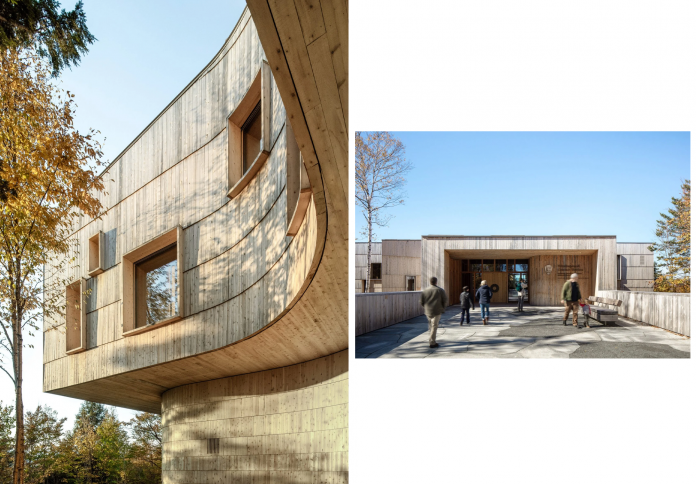On a remote mountaintop in northern Maine, Saunders Architecture has unveiled Tekαkαpimək Contact Station, a striking visitor centre that serves as both a gateway to the Katahdin Woods and Waters National Monument and a tribute to the Wabanaki peoples who have long called this region home. With its cedar-clad form rising above the trees and panoramic views that stretch “as far as one can see,” the project blends thoughtful architecture with cultural reverence and environmental harmony.
A cultural threshold in the heart of nature
Perched atop Lookout Mountain within the ancestral lands of the Penobscot Nation, Tekαkαpimək Contact Station officially reopened to the public on June 21, 2025. The name—pronounced “deh gah-gah bee mook”—is a Penobscot word meaning “as far as one can see,” and the centre’s location lives up to that promise with sweeping views across the forested landscape of northern Maine.
On a remote mountaintop in northern Maine, Saunders Architecture has unveiled Tekαkαpimək Contact Station, a striking visitor centre that serves as both a gateway to the Katahdin Woods and Waters National Monument and a tribute to the Wabanaki peoples who have long called this region home. With its cedar-clad form rising above the trees and panoramic views that stretch “as far as one can see,” the project blends thoughtful architecture with cultural reverence and environmental harmony.
A cultural threshold in the heart of nature
Perched atop Lookout Mountain within the ancestral lands of the Penobscot Nation, Tekαkαpimək Contact Station officially reopened to the public on June 21, 2025. The name—pronounced “deh gah-gah bee mook”—is a Penobscot word meaning “as far as one can see,” and the centre’s location lives up to that promise with sweeping views across the forested landscape of northern Maine.
Designed by the Norwegian-Canadian studio Saunders Architecture in collaboration with a Wabanaki advisory board, the 7,900-square-foot centre sits on a 23-acre site and serves as an introduction to the Katahdin Woods and Waters National Monument. The monument itself occupies lands significant to the Wabanaki Confederacy—comprising the Maliseet, Mi’kmaq, Passamaquoddy, and Penobscot Nations—and plays a vital role in preserving both cultural heritage and natural ecosystems.
Architecture shaped by land and tradition
The design of the centre is as symbolic as it is functional. The building is arranged in a cross-like plan with an extra diagonal wing that cantilevers out from the east-facing entry volume—gesturing toward the dawn. This geometry isn’t arbitrary; it draws from the spiritual and geographic orientation of Wabanaki traditions. The site’s overall layout, developed with landscape architects Reed Hilderbrand, enhances this symbolism with a terraced plaza that steps through the forest toward an eastern lookout and a ceremonial gathering circle.
Visitors arriving at the centre are greeted by a sloping cedar-clad structure that rises subtly from its forested base. Inside, the building opens into double-height volumes lined with warm Douglas fir, creating a welcoming atmosphere that frames expansive views in all four cardinal directions. Large bird-safe windows invite the landscape in, while three wood-burning fireplaces offer comfort during Maine’s long winters.
“As singular as its surroundings, Tekαkαpimək is a work of collaborative design and construction, intentionally imbued with Wabanaki knowledge,” said the project team. Every material choice and spatial gesture was made in partnership with Indigenous communities, ensuring that the architecture reflects local traditions, environmental stewardship, and cultural resilience.
A living classroom of Wabanaki culture
Inside the contact station, each wing hosts curated exhibits that educate visitors about the region’s geography, ecology, and deep cultural history. Wabanaki oral traditions, artifacts, artworks, and interactive displays guide guests through centuries of Indigenous knowledge and environmental interaction. At the heart of the space, an attendant desk offers trail information and cultural context to deepen the visitor experience.
The structural design itself contributes to the narrative. Glulam (glued laminated timber) columns form deep, expressive walls that support the roof and frame seating areas for rest and reflection. Throughout the building, moments of quiet are embedded into the design—from shadowed reading nooks to wide, contemplative windows looking out over the landscape.
The building doesn’t just inform—it embodies. The interplay of natural materials, native plantings, and light animates the space through the seasons, while its energy-efficient construction and sensitive site placement affirm its environmental responsibility. It’s a place that encourages connection: to the land, to history, and to the future.
A gift of land, a sanctuary of dark skies
The Katahdin Woods and Waters National Monument owes its existence to Roxanne Quimby, cofounder of the Burt’s Bees skincare brand, who began acquiring land in the early 2000s with a vision of preservation. Her donation of 87,563 acres in 2016 made the monument possible, and the site is now managed by the U.S. National Park Service. In recognition of its pristine night skies and low light pollution, the area has been designated an International Dark Sky Sanctuary—one of the few in the eastern United States.
Tekαkαpimək serves not just as a welcome centre but as a spiritual and educational waypoint for the thousands of people who visit these protected lands. It is a project that expands beyond architecture to become a meaningful cultural landmark—rooted in place, guided by Indigenous voices, and open to all.
A continued legacy of remote architecture
Saunders Architecture, founded by Canadian architect Todd Saunders, has long been known for its poetic responses to remote landscapes. The studio’s work on Fogo Island in Newfoundland—including artist residencies, galleries, and a hotel—set a precedent for architecture that listens deeply to land and culture.
With Tekαkαpimək Contact Station, the studio brings that same sensibility to Maine, collaborating closely with the Wabanaki Nations to create a space that is not just visited but experienced. It is a new chapter in the evolving story of the American landscape—one where architecture acts not as an imposition but as a respectful partner to both people and place.
Designed by the Norwegian-Canadian studio Saunders Architecture in collaboration with a Wabanaki advisory board, the 7,900-square-foot centre sits on a 23-acre site and serves as an introduction to the Katahdin Woods and Waters National Monument. The monument itself occupies lands significant to the Wabanaki Confederacy—comprising the Maliseet, Mi’kmaq, Passamaquoddy, and Penobscot Nations—and plays a vital role in preserving both cultural heritage and natural ecosystems.
Architecture shaped by land and tradition

The design of the centre is as symbolic as it is functional. The building is arranged in a cross-like plan with an extra diagonal wing that cantilevers out from the east-facing entry volume—gesturing toward the dawn. This geometry isn’t arbitrary; it draws from the spiritual and geographic orientation of Wabanaki traditions. The site’s overall layout, developed with landscape architects Reed Hilderbrand, enhances this symbolism with a terraced plaza that steps through the forest toward an eastern lookout and a ceremonial gathering circle.
Visitors arriving at the centre are greeted by a sloping cedar-clad structure that rises subtly from its forested base. Inside, the building opens into double-height volumes lined with warm Douglas fir, creating a welcoming atmosphere that frames expansive views in all four cardinal directions. Large bird-safe windows invite the landscape in, while three wood-burning fireplaces offer comfort during Maine’s long winters.
“As singular as its surroundings, Tekαkαpimək is a work of collaborative design and construction, intentionally imbued with Wabanaki knowledge,” said the project team. Every material choice and spatial gesture was made in partnership with Indigenous communities, ensuring that the architecture reflects local traditions, environmental stewardship, and cultural resilience.
A living classroom of Wabanaki culture

Inside the contact station, each wing hosts curated exhibits that educate visitors about the region’s geography, ecology, and deep cultural history. Wabanaki oral traditions, artifacts, artworks, and interactive displays guide guests through centuries of Indigenous knowledge and environmental interaction. At the heart of the space, an attendant desk offers trail information and cultural context to deepen the visitor experience.
The structural design itself contributes to the narrative. Glulam (glued laminated timber) columns form deep, expressive walls that support the roof and frame seating areas for rest and reflection. Throughout the building, moments of quiet are embedded into the design—from shadowed reading nooks to wide, contemplative windows looking out over the landscape.

The building doesn’t just inform—it embodies. The interplay of natural materials, native plantings, and light animates the space through the seasons, while its energy-efficient construction and sensitive site placement affirm its environmental responsibility. It’s a place that encourages connection: to the land, to history, and to the future.
A gift of land, a sanctuary of dark skies
The Katahdin Woods and Waters National Monument owes its existence to Roxanne Quimby, cofounder of the Burt’s Bees skincare brand, who began acquiring land in the early 2000s with a vision of preservation. Her donation of 87,563 acres in 2016 made the monument possible, and the site is now managed by the U.S. National Park Service. In recognition of its pristine night skies and low light pollution, the area has been designated an International Dark Sky Sanctuary—one of the few in the eastern United States.

Tekαkαpimək serves not just as a welcome centre but as a spiritual and educational waypoint for the thousands of people who visit these protected lands. It is a project that expands beyond architecture to become a meaningful cultural landmark—rooted in place, guided by Indigenous voices, and open to all.
A continued legacy of remote architecture
Saunders Architecture, founded by Canadian architect Todd Saunders, has long been known for its poetic responses to remote landscapes. The studio’s work on Fogo Island in Newfoundland—including artist residencies, galleries, and a hotel—set a precedent for architecture that listens deeply to land and culture.
With Tekαkαpimək Contact Station, the studio brings that same sensibility to Maine, collaborating closely with the Wabanaki Nations to create a space that is not just visited but experienced. It is a new chapter in the evolving story of the American landscape—one where architecture acts not as an imposition but as a respectful partner to both people and place.










